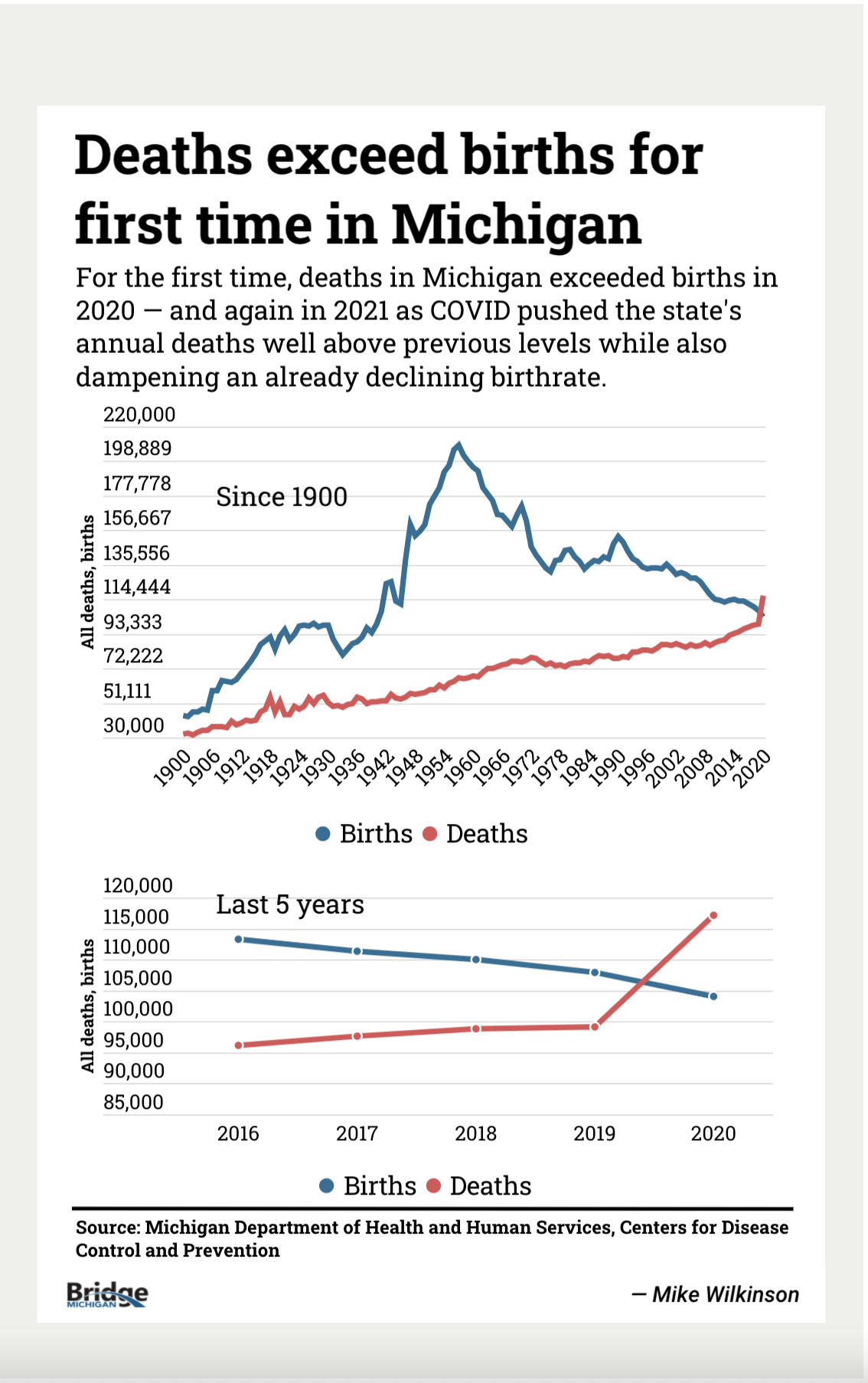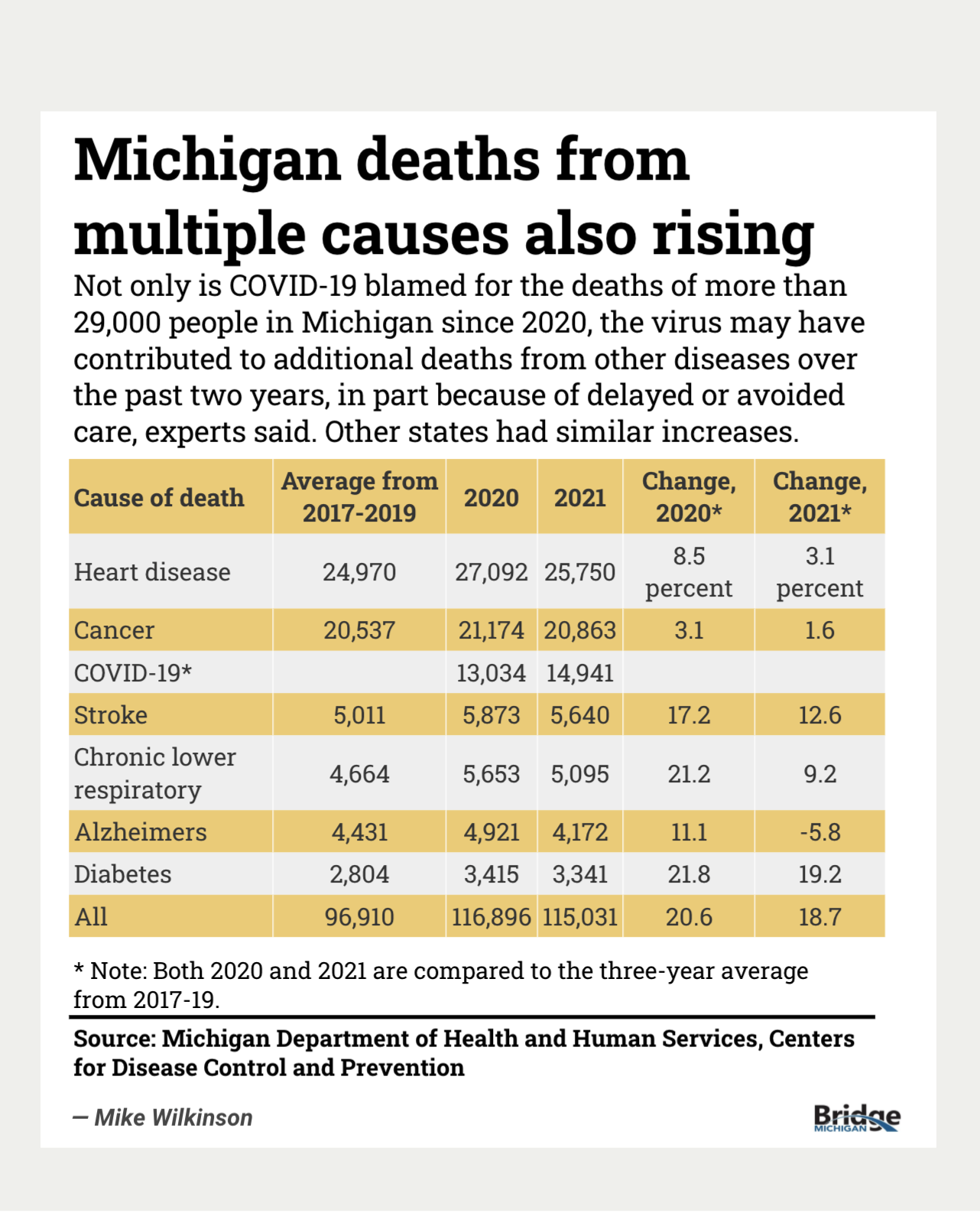Deaths exceed births in Michigan. Blame COVID, but long-term trends are grim

Mike Wilkinson (Michigan Health Watch, Bridge Michigan)
Deaths now exceed births in Michigan. That’s bad news for the economy, and a problem that has been years in the making.
The COVID-19 pandemic super-charged a demographic nightmare that’s been brewing for years. In 2019, deaths exceeded births in 55 of 83 counties, and demographers warned that was a threat to the state’s vitality.
Now, federal data shows that in 2020, the state’s death rate has exceeded the birth rate, with more than 117,000 deaths in 2020 (including 13,000 from COVID) compared to 104,074 births.
Just a generation earlier, in 2000, there were 49,060 more births than deaths in Michigan.
What happened in Michigan occurred across the nation. In 2019, just five states recorded more deaths than births but in 2020 that number jumped to 25 states.
Florida has the fifth-oldest population in the nation, making many of its residents susceptible to the virus. In 2019, the state had 13,000 more births than deaths. In 2020, that flipped, with 30,000 more deaths than births.
Michigan went from 8,802 more births than deaths in 2019 to 13,032 more deaths than births in 2020.
Complete birth records are not available for 2021 but, if 2020 is a guide, births will decline again. They fell 3.6 percent in 2020 from 2019, far more than the average drop of 1.6 percent the previous four years.
It is a sign that Michigan followed the national trend of an even steeper decline in births during the pandemic.
Why does it matter?
- Political clout: Michigan lost population from 2000 to 2010 and was so stagnant again from then until 2020 that the state’s congressional delegation is falling this year from 14 to 13. In the 1990s, Michigan had 16 seats.
- Economy: Studies also show that the economy generally slows as its population becomes older. Fewer people are in the workforce, and government budgets can get pinched by spending on services and health care.
- On the other hand: Much of that thinking about the economy is based on presumptions about older people that advocates like the AARP would dispute. Those over 50 in the United States alone, the advocacy group contends, contribute more than $8 trillion to the economy, an amount that would be equal to the third-largest economy in the world.
Is the trend reversible?
Maybe.
Although Michigan is among the bottom 10 states in terms of the percent of women of childbearing age, it has been relatively rare for women — or men — of those ages to die from COVID-19. Of the 29,605 who have died since March of 2020, 94 percent were 50 or older.
Also, birth rates rebound after bigger dips. In 2013, 2014 and 2016, births rose just a couple years after the Great Recession suppressed births.
And many of those who died from COVID-19 were 70 or older and died prematurely. Because they died during the pandemic, overall death totals in future years could actually decline.
Another way to reverse trends is immigration, advocates say. But net international immigration into Michigan fell to 7,800 in 2020 from 21,000 in 2017, in part because of crackdowns imposed by former President Donald Trump,
Still, the long-term trend is clear
Make no mistake: Michigan is aging faster than the rest of the nation.
In 2019, the state had the 14th oldest median age in the nation at 39.8 years; in 2000 it was 29th (35.5 years). The 12 percent jump in 20 years was the eighth biggest in the country.
Twenty counties in the state have a median age 50 or older (it's nearly 60 in the Upper Peninsula’s Ontonagon County) and in another 47 counties it’s between 40 and 50.
Of the fastest growing states, all but Florida have lower median ages than Michigan’s.
Want more bad news?
The virus hasn't just killed people with COVID. It’s also blamed for an uptick in overall deaths in 2020 and 2021, with people unwilling or unable to seek care for emergencies or chronic conditions.
Although COVID-19 deaths alone in 2020 would have caused a 13 percent increase in deaths, all deaths rose 20 percent over the three-year average from 2017-19.
- Heart disease, the leading cause of death in Michigan, was blamed on 27,092 deaths in 2020, an 8.5 percent increase over the 2017-19 average.
- Diabetes deaths rose nearly 22 percent and chronic lower respiratory deaths were up 21 percent.
With no lockdowns in 2021, it was easier to get care throughout the year but there were still substantially more deaths among certain causes, like diabetes and stroke.









You must be logged in to post a comment Login